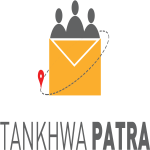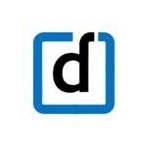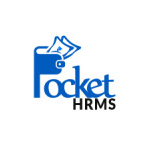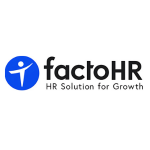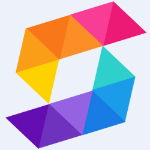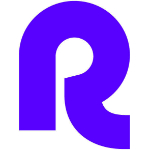
TechnologyCounter provides genuine, unbiased real user reviews to help buyers make informed decisions. We may earn a referral fee when you purchase through our links, at no extra cost to you.
List Of 15 Best HR Software In India For HR Managers in 2025
Showing 1 - 15 of 714 products
Remote
The new standard in global HR
Remote, the innovative HR software that is revolutionizing the way we work. With its user-friendly interface features, Remote allows you to seamlessly connect and collaborate with your team from anywhere in the world. Say goodbye to the limitations o...Read Remote Reviews
Keka is a Modern HR and Payroll software for small and medium sized businesses that manage employee engagement, it has time tracking, attendance management, and leave management system...Read Keka HR Reviews
HROne is the product of Uneecops Workplace Solutions Private Limited which is a subsidiary of Uneecops Group. a 450 Cr. Conglomerate established in 1996...Read HROne Reviews
Zoho People is a comprehensive, cloud-based HR software that helps businesses of every size and type to streamline their HR operations and improve business efficiency. It provides comprehensive services such as onboarding, time and attendance, perfor...Read Zoho People Reviews
greytHR is an integrated cloud-based HR and payroll software with 100% statutory compliance. It reduces and simplifies transnational HR tasks while delivering reliable and quick results. It also automates all the HR transactions by a single login das...Read greytHR Reviews
Beehive is one of the fast emerging leaders in providing the companies with the Cloud-based and or an On-premise HRMS software that lists out a number of highly effective features to run HR functions efficiently...Read Beehive HRMS Reviews
All-In-One HR Platform.36 apps covering all your requirements across core HR, talent management, payroll and business expenses...Read Qandle Reviews
Trusted by 2500+ customers, Zimyo is a unified HR and payroll software that helps automate tedious HR processes, eliminate payroll errors, and foster positive employee experiences. It offers a comprehensive suite of 50+ modules, including a Core HR,...Read Zimyo Reviews
Mature HRMS solutions which have been in the market for over 12 yrs,800+ clients with over a lakh of employees successfully managed by our HRMS solutions.Core team has a cumulative experience of over 60 yrs in HR...Read 247HRM Reviews
Tankhwa Patra is a leading HRMS and Payroll Software which acts as your digital HR Super Hero which makes the work of HR easy...Read Tankhwa Patra Reviews
Darwinbox is a unified HRMS platform, designed for HR leaders of large enterprises across various industries. Empower HRs to manage the entire employee life cycle(hire to retire) on one platform...Read Darwinbox Reviews
Pocket HRMS can revolutionize your HR and Payroll operations by completely digitalizing your Payroll processing, attendance, digital onboarding, and HR operations, allowing your employees to access their information anywhere anytime using the latest...Read Pocket HRMS Reviews
factoHR is a Cloud-based HR & payroll software for SMEs. Automates payroll, attendance, leave, and compliance. Saves time, reduces errors, and provides mobile access to employees via its Employee Self Service (ESS)...Read factoHR Reviews
ZingHR is a cloud-based human resource management software and payroll system tailored exclusively for Indian businesses. It offers a comprehensive solution for your entire organizations needs, as well as a dashboard of all staff activity...Read ZingHR Reviews
skillaHR is a all-in-one HR management software designed to streamline your HR processes and revolutionize the way you manage your workforce. With skillaHR, say goodbye to tedious paperwork and hello to efficient and organized employee management. Tr...Read skillaHR Reviews
- What is HR Software?
- HR Software Checklist for Your Business
- The Main Advantages of HR Software for Organizations
- Features to Look for in HR Software in India
- How to Choose the Right HR Software
- What to Expect from HRMS Software
- Are There Different Types of HR Software?
- Different Types of HR Software
- Pitfalls of Choosing Free HR Software Systems
- Demo Questions for Vetting HR Software
- Implementing an HR Software
- HR Software Trends
- What are the Average Implementation Times for HR Software?
- Are There Any Hidden Costs Associated with HR Software?
- How do HR Platforms Address Data Security?
- Conclusion
HR Software Buyer's Guide
Businesses or HR teams often struggle to choose the right HR Software to simplify their daily HR tasks. Picking the right system is tricky as this highlights that it's more than just a payroll tool.
By understanding the key features to look for in HR Software, you can ensure it meets your needs. The stages in this buyer's guide will assist you in choosing the best HR software India alternative and making an educated choice.
There is undoubtedly a software option that is ideal for your company among the numerous that are accessible. After you locate it, everything begins to come together.
Start your human resources journey today! Request a free demo now!
What is HR Software?
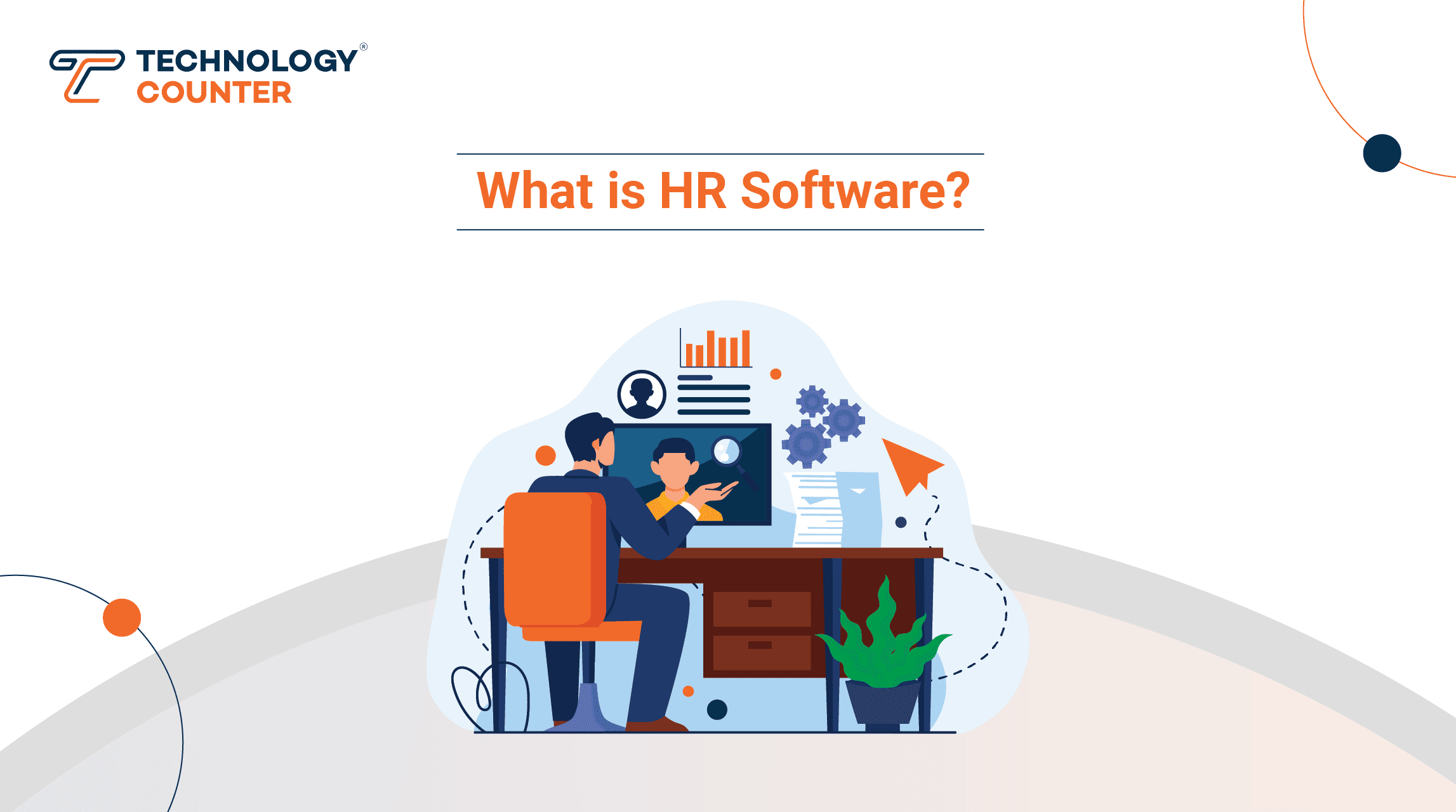
Human resources software is any-tool, app, or program That helps improve how your business manages its people. It covers tasks like keeping employee records, employee onboarding, payroll, performance management, recruiting, and training.
Most HR software India is designed to make your team's work easier by - automating tasks and storing all employee data in one central place. Software that is installed directly on your systems or Software as a Service, which is a cloud-based solution, are both options available to you.
If you want to purchase an HR system, begin by determining which HR process activities need the most improvement. Talk to your HR team to learn, which activities take the most time, lead to mistakes, or cause frustration.
These areas are a great starting point for choosing the best HR software in India that can make a real difference for your team.
HR Software Checklist for Your Business
Now let us take a look at the top HR software in India requirements for your particular business before you buy one.
-
The Size of Your Company Matters
Small businesses with fewer employees often rely on manual spreadsheets and paper forms for tasks. For instance, if the business owner also manages HR, having a digital system simplifies the workload, ensuring smoother operations. Modern and top HR software is designed to be user-friendly, offering step-by-step guidance for tasks like payroll, attendance, and employee management.
For larger organizations, automating HR processes is a necessity rather than a choice. However, managing onboarding, employee engagement, performance evaluations, and training programs often call for more advanced software.
-
HR and Business Growth
If you plan to expand your business, the best HR management software becomes essential. Modern HR systems do more than simply automate tasks. They also use analytics to give you valuable information about your workforce.
Applicant tracking systems (ATS) and recruitment management software (RMS) help expedite the recruiting process. These tools allow you to post job openings on multiple platforms, screen resumes, schedule interviews, and track candidates through the hiring pipeline.
|
Did you know– Strong onboarding procedures may increase productivity by more than 70% and new recruit retention by 82%, according to Glassdoor research. |
Predictive analytics is another powerful feature of HR software. It helps businesses track metrics like hiring quality, cost of recruitment, and the effectiveness of different hiring channels.
With this data, companies can improve recruitment strategies, address gaps, and enhance employee performance management. Analytics also support better engagement strategies by highlighting areas that need attention.
-
The Role of AI in HR
AI has revolutionized recruitment processes. Intelligent software can scan resumes, remove biases, message multiple candidates at once, and rank applicants based on their fit for the role.
For example, Vodafone implemented AI to analyze video interviews, assessing factors like role compatibility, body language, and speech patterns.
This approach cut recruiting time by 50% while processing applications from over 50,000 prospects.
Beyond recruiting, artificial intelligence is being utilized to improve employee engagement. Chatbots answer routine questions in real time, while AI-driven surveys like collecting feedback and providing actionable insights.
HR analyst Josh Bersin shared an example where AI analyzed employee feedback to match individuals with high-performing teams. Within three months - this approach led to a 25% improvement in corporate values by promoting small, behavior-based changes.
-
Balancing Technology with the Human Touch
Many businesses use HR automation hastily without fully comprehending the ramifications. This might result in the needless removal of jobs that need sensitivity and originality.
Instead, focus on automating administrative tasks like-
-
basic data administration,
-
payroll, and
-
attendance.
It gives HR professionals more time to focus on important areas like employee well-being, leadership, and culture. The HR approach focuses on minimizing transactional work in order to maximize HR's impact.
By committing less time to boring tasks, HR professionals can focus on strategic initiatives that boost productivity and business culture.
Even if these solutions meet certain standards - it is critical to consider how HR professionals will use the time that automation saves them. This time is best spent participating in activities that promote a healthy and supportive workplace atmosphere.
Before deciding on HR software - create a list of labor-intensive jobs that do not need innovation. Automate these tasks if technology can accomplish them faster and more accurately.
However, tasks requiring judgment, empathy, or face-to-face communication should continue to be human-centered.
Choosing the best HR software India should boost your organization's -overall efficiency and work culture - while also automating operations.
Recommended Read: Best HR Software for Small Businesses – Compare features, pricing, and benefits of top HR tools to optimize your business.
The Main Advantages of HR Software for Organizations
Using HR software provides several advantages to firms, making it an excellent alternative for boosting human resource management practices.
Let us now explore the main benefits of HR software in an organization.
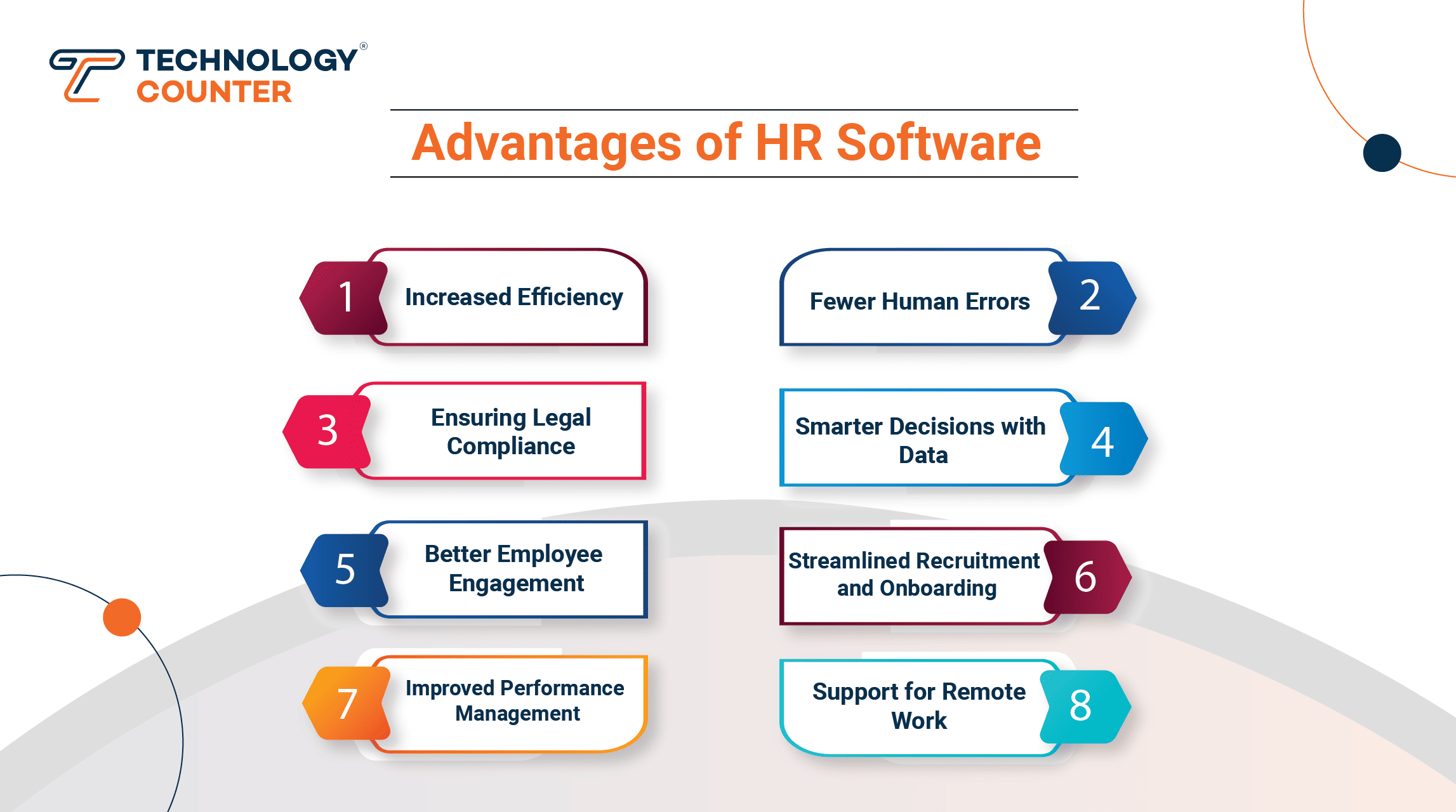
-
Increased Efficiency
HR software automates tasks like onboarding, recruitment, payroll, and tracking employee hours.
This allows HR teams to spend less time on routine administration and more time on projects that grow the business and support employee development.
|
Did you know? Companies like Google, Amazon, and Microsoft have successfully adopted these tools. Proving that modern HR solutions drive efficiency. |
-
Fewer Human Errors
Switching to HR software significantly reduces errors caused by manual data entry. Handling payroll and HR manually can be time-consuming and prone to mistakes. But modern HR tools ensure accurate data processing.
These systems integrate smoothly with payroll software, making it easier to manage wages and benefits without errors. It has become a global standard, helping businesses better manage their employees.
-
Ensuring Legal Compliance
HR software helps organizations comply with labor laws and regulations. It keeps track of important requirements like GDPR, employee verification, tax rules, and health and safety training.
It reduces the burden on HR managers while ensuring the company meets all legal obligations. Compliance is critical for avoiding fines and maintaining a good reputation and HR software makes it easier to monitor and report on these areas.
-
Smarter Decisions with Data
Analytics provided by HR software allows businesses to make informed decisions. With access to detailed data, HR teams can plan for future workforce needs, identify high turnover risks and create initiatives to boost employee performance and satisfaction.
Using these insights, companies can develop strategies that improve workplace culture and achieve organizational goals. A reliable HR management system in India can transform a business by fostering a happy workforce leading to positive outcomes.
-
Better Employee Engagement
Many companies struggle with low employee engagement. But HR software offers tools to address this issue. Sentiment analysis features gauge how employees feel, while surveys and polls provide continuous feedback.
Modern HRMS platforms include mood tracking, communication tools, and feedback systems like 360-degree reviews.
To foster collaboration and boost engagement. These solutions create a supportive work environment and strengthen the connection between employees and the organization.
-
Streamlined Recruitment and Onboarding
HR software simplifies the hiring process through applicant tracking system. These tools automate tasks like posting job openings, screening candidates, scheduling interviews, and onboarding new hires.
Organizations can attract top talent and create a pleasant onboarding experience for new workers by speeding up and optimizing recruiting processes.
-
Improved Performance Management
Performance management tools within HR software help track employee progress, set goals, gather feedback, and conduct performance reviews.
These features promote continuous improvement and ensure employees receive the guidance they need to grow. With streamlined performance management, businesses can foster a culture of development and achieve their objectives.
-
Support for Remote Work
HR software enables workers to access systems from any location, allowing for more flexible work arrangements. This guarantees that HR activities function efficiently, even when teams are working remotely or in multiple locations.
It is the most essential feature in today's work climate when remote work is becoming more frequent.
-
Cost Savings
By optimizing processes, reducing errors, and improving efficiency, HR software saves organizations money on HR administration and compliance. It eliminates manual inefficiencies, cutting costs while delivering better outcomes.
Investing in HR software is a long-term, cost-effective solution for managing a workforce. HR software is an essential tool for modern organizations, offering a wide range of benefits that streamline processes and improve employee satisfaction. From automating tasks to providing data-driven insights, these systems empower HR teams to focus on strategic initiatives.
Whether your organization is large or small, integrating the best HRMS software into your operations can drive efficiency, save costs, and create a positive work environment.
Features to Look for in HR Software in India
If you're new to HR software, you might wonder what features you should focus on when choosing the right one. While some options are free - it's not always about picking the software with the most features.
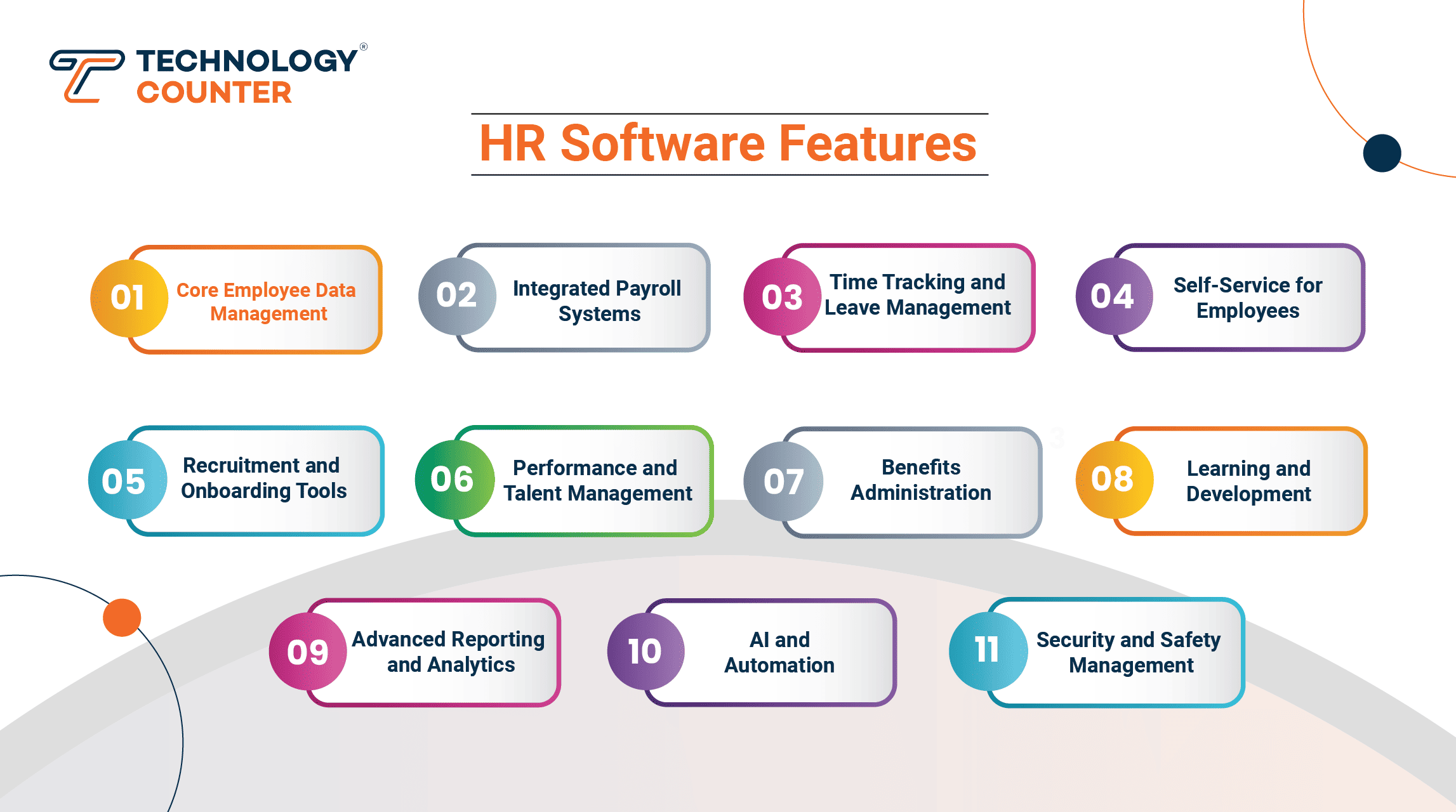
With that in mind, let's go over the must-have features most HR professionals look for:
1. Core Employee Data Management
Think of this as the heart of your HR system. It stores all employee information and automatically updates across all modules - no need to manually input data again and again. This single source of truth makes everything from payroll to benefits administration more accurate and efficient.
2. Integrated Payroll Systems
Forget complicated calculations and late paydays. A good HR system ensures salaries are processed accurately, taxes are deducted properly, and pay stubs are always ready.
It's a must-have for stress-free payroll management.
3. Time Tracking and Leave Management
Managing attendance and vacation requests can get messy. With the right tools, employees can clock in and out, request leave, and track their schedules, all this without bogging down HR.
4. Self-Service for Employees
Do your HR staff get bombarded with questions about leave balances or payslips? A self-service portal lets employees handle these queries themselves saving time for everyone. It's empowering and boosts productivity across the board.
5. Recruitment and Onboarding Tools
Hiring can be tough, but recruitment modules with applicant tracking systems and pre-made templates make it easier. Once you find the right talent , onboarding tools ensure a smooth transition by automating processes like document verification and resource sharing.
6. Performance and Talent Management
Keeping track of employee performance is crucial for growth. HR software with performance management tools can help with regular reviews, goal tracking, and development plans.
For talent retention, features like employee satisfaction surveys and reward programs make sure your best people stay happy.
7. Benefits Administration
Managing benefits like health insurance, bonuses, or retirement plans can be complicated. The right HR software links benefits to payroll simplifying things for both HR and employees. This ensures everyone gets what they deserve without the headache.
8. Learning and Development
As technology evolves, so should your employees. Learning management systems (LMS) in HR software track certifications offer training programs and help employees upgrade their skills. It's a win-win for staff and the company.
9. Advanced Reporting and Analytics
HR isn't just about people, it's also about data. Real-time analytics and customizable reports provide insights into employee performance, retention trends, and more. It's like having a crystal ball for smarter decision-making.
10. AI and Automation
With AI becoming a big deal, more HR tools now use it to automate repetitive tasks, like screening resumes or managing workflows. It saves time and allows HR to focus on more strategic activities.
11. Security and Safety Management
Employee data is sensitive and good HR software keeps it secure with encrypted systems, password protection, and regular updates to prevent breaches.
12. The All-in-One Dashboard
Need a quick overview? Dashboards pull together everything from attendance, birthdays, leave requests, and more.
In one easy-to-navigate view, your HR team will love to use the control centre.
How to Choose the Right HR Software
Many software companies will attempt to dazzle you with features like excellent benefits administration or seamless payroll processing. But what if you do not really need those?
Big promises might easily influence you, but before you commit, take the time to go through these steps to determine which one best suits your requirements.
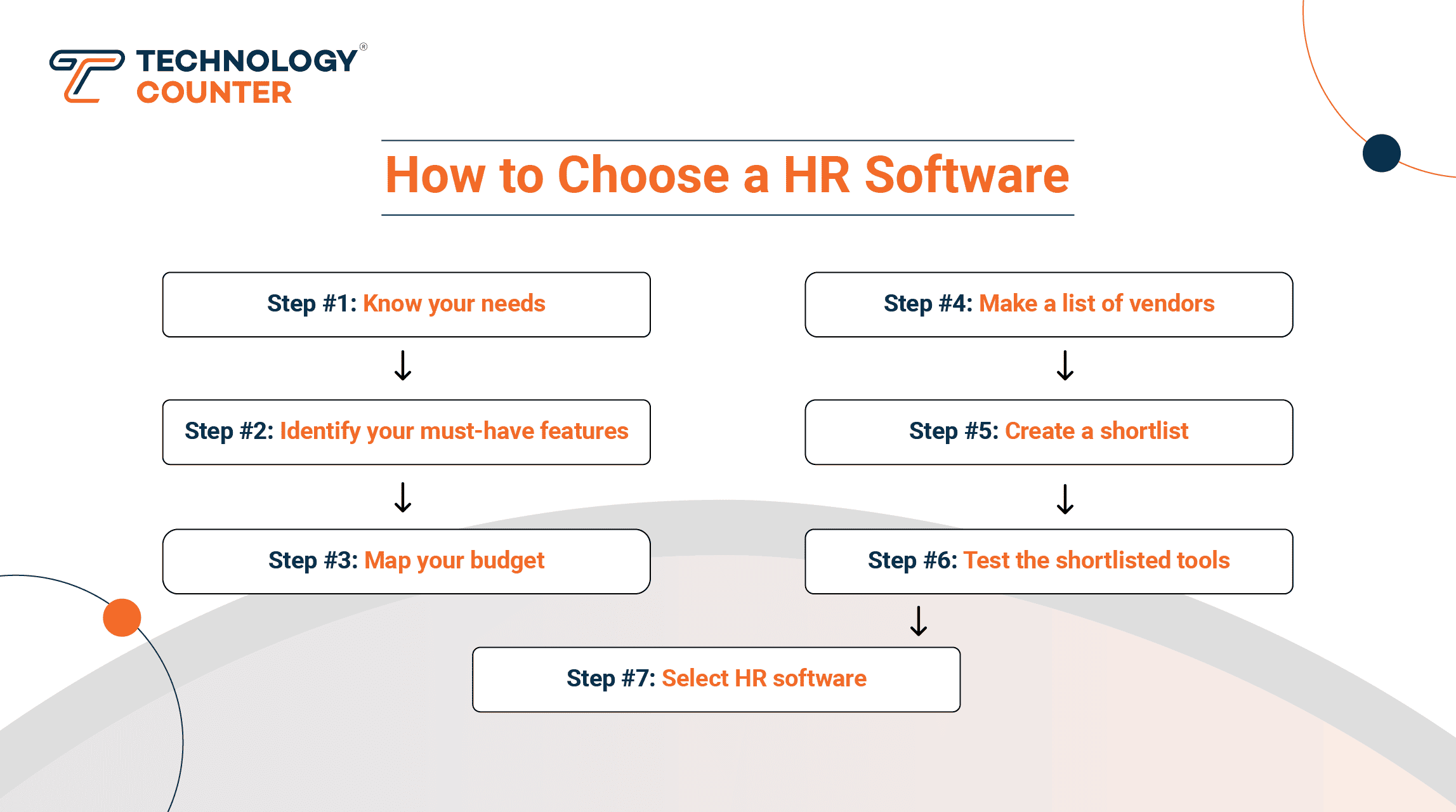
Step #1: Know your needs
Knowing the demands of your company is the first step in selecting the best software. What issue are you attempting to resolve, ask yourself? Is it to make onboarding smoother? Or to improve how you assess talent?
Evaluate your existing processes carefully to find areas of inefficiency and areas for improvement. The following are some useful inquiries to assist you:
-
Do workers find the existing system satisfactory?
-
Is the HR system you are using not fulfilling your needs?
-
Are there stringent data security procedures in place at your company?
-
Does your staff feel at ease using technology, or will they need more assistance to adjust?
-
What are the main obstacles that your human resources personnel must overcome?
-
What is your target return on investment (ROI), and what is your budget?
-
Which HR duties need excessive time?
You can identify the best solution for your requirements by providing answers to these questions.
Step #2: Identify your must-have features
Everybody has a wish list; it might be for designer clothing or a new device. There is little difference in selecting an HR solution. It is time to concentrate on the aspects that are most important when you have determined what your company requires.
When evaluating HR solutions, start by making a list of the characteristics you absolutely must have and rank them. Here are some essentials you'll want:
|
Analytics and reporting |
Offers information on absence and turnover |
|
Employee self-service |
Increases output by allowing workers to manage their own data |
|
Management of recruiting and onboarding |
Reduces the burden of the hiring process |
One non-negotiable feature is integration. This lets you access data systematically across tools. For instance, HRIS sync connects employee data from your HR software, so it's accessible wherever you're working , no need to switch platforms. AI search may also give you quick answers right in your workflow.
Once your list is ready narrow down your options to find the right tool. Focus on a solution that fixes your current pain points first. You can always expand later as your needs grow.
Step #3: Map your budget
After much research, you've finally found the perfect tool. But then you see the price it's way more than you expected. And you realize it's out of your budget. That's why setting a budget is a crucial step before making a costly mistake.
Talk to key decision-makers like your finance, management, and HR teams. Remember, the cost of HR software depends on factors like your business size, the features you need, and the pricing model.
Be clear about how much you're willing to spend. But don't forget about extra costs. For example, some tools charge for migration and setup. This can significantly increase the initial price. Plan ahead to avoid surprises!
Step #4: Make a list of vendors
The HR software industry is brimming with excellent solutions for assisting firms in achieving their objectives. And it's expected to grow to $62.5 billion by 2032.
The downside? Making the perfect choice might be difficult when there are so many alternatives available. We can help by guiding you through the process to make it simpler.
Start by looking at buyer's guides, such as this one. These helpful pieces compare top HR tools, giving you a clear idea of which one fits your needs best.
To simplify your search, here are some questions to consider:
-
Are the reviews and ratings positive in its category?
-
Does it meet your specific needs and expectations?
-
Does it offer a free trial or demo?
-
Is it designed for small businesses, large enterprises, or both?
-
Is it user-friendly, or does it complicate things?
-
Is it within your budget?
-
What do users say about it?
-
What's its standout feature?
-
What are the best tools for your company?
You may reduce your selections by providing answers to these questions. Now, let us go to the next phase!
Step #5: Create a shortlist
You've got a long list of HR software that meets your needs, fits your budget, and has all the features you want. But you're still stuck on which one to choose.
That's where this step helps.
|
Ask your team |
Get feedback from colleagues to see which option they think works best. |
|
Check reviews |
Visit trusted sites to see what users are saying. |
|
Look for case studies |
Many vendors share real-life examples of how their tools solved problems for other businesses. |
|
Reach out to sales reps |
Have questions or doubts? Contact the vendors directly to clarify everything. |
These steps will help you zero in on the best fit for your business.
Step #6: Test the shortlisted tools
Got your shortlist ready? Great! Now, it's time to try them out.
Many HR software tools offer demos, free plans, or trials, so you can see how they operate before making a judgment. Even if a tool seems great on paper or in images, it may not be as simple to use as you believe.
Testing it out on your own or with your HR staff can help you determine if it is worth the money. When making your final decision, remember to consider the comments from your HR staff.
Step #7: Select HR software
The decision-making time is here! You might be sure about your choice. But is your HR team on the same page? Do they feel comfortable with it?
Your staff may be anxious about using a new tool if they are not extremely tech-savvy. It is crucial to explain the new HR software to them in detail and to urge them to voice any concerns to a higher-up.
Also, some vendors offer training and onboarding resources to help your team get comfortable with the tool. Make sure they take advantage of these so you can smoothly integrate the tool into your HR processes.
Develop custom human resource software for your business NOW! Schedule a demo!
What to Expect from HRMS Software
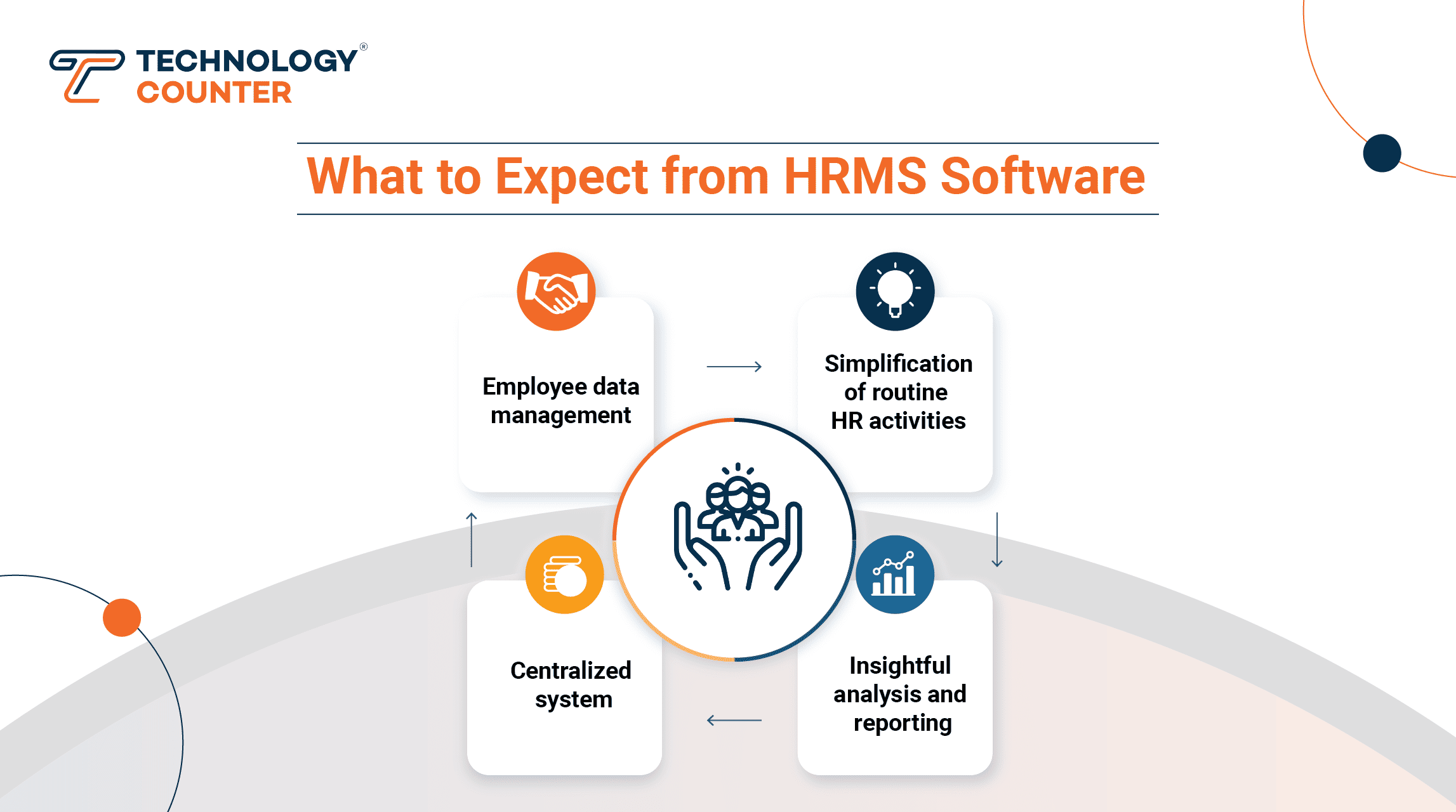
-
Employee data management
Employee data management includes everything from onboarding new employees to track performance, handling payroll, and managing benefits. The software should be able to track, store, and manage all employee data, Collecting, storing, and processing employee data is usually a routine task for all employees and doesn't need much change. So, it's important to find software that automates these processes.
The best software keeps it simple, automates tasks, and saves time and effort.
-
Simplification of routine HR activities
Automation is a key feature for simplifying routine HR tasks. These tasks are often repetitive and can become overwhelming. So, technology should help streamline them. If the software can't do that, it's not useful!
Look for software that offers high automation. A clear, step-by-step process reduces mistakes and makes things easier.
For example, when onboarding a new employee there should be a clear set of steps from hiring to training. The important information the new employee needs to know should be outlined. And the process of educating them should be organized with specific people handling each part.
-
Insightful analysis and reporting
Good analysis and reporting are essential for making decisions based on data. Without HRMS software HR teams would have to manually gather, analyze, and create reports.
It's a lot of work!
The key question is- "What's the point of HRMS software if it doesn't do this heavy lifting?"
The right HRMS software should help with analyzing employee and company data making it easier for HR teams to focus on more strategic decisions.
-
Centralized system
Good HRMS tools in India should have a centralized storage system where all employee files, company documents, and procedures are stored in one place.
Ideally, it should be automated.
The benefit of this is that having everything in one place helps avoid mistakes that can happen when changes need to be made in multiple areas manually.
The system should work smoothly with other systems, so when changes are made like work hours, benefits, or payroll they automatically update across the system and in the right departments.
Are There Different Types of HR Software?
The HR software market includes many different types of tools. While it's a broad field, the best HR software in this list can be grouped into a few main categories:
-
HCM -Human Capital Management System
-
HRIS -Human Resources Information System
-
HRMS -Human Resource Management System
Other popular types include:
-
Workforce management software
-
Applicant tracking or recruiting software
For more details, you can check out this article on the different types of HR software and their key benefits.
Different Types of HR Software
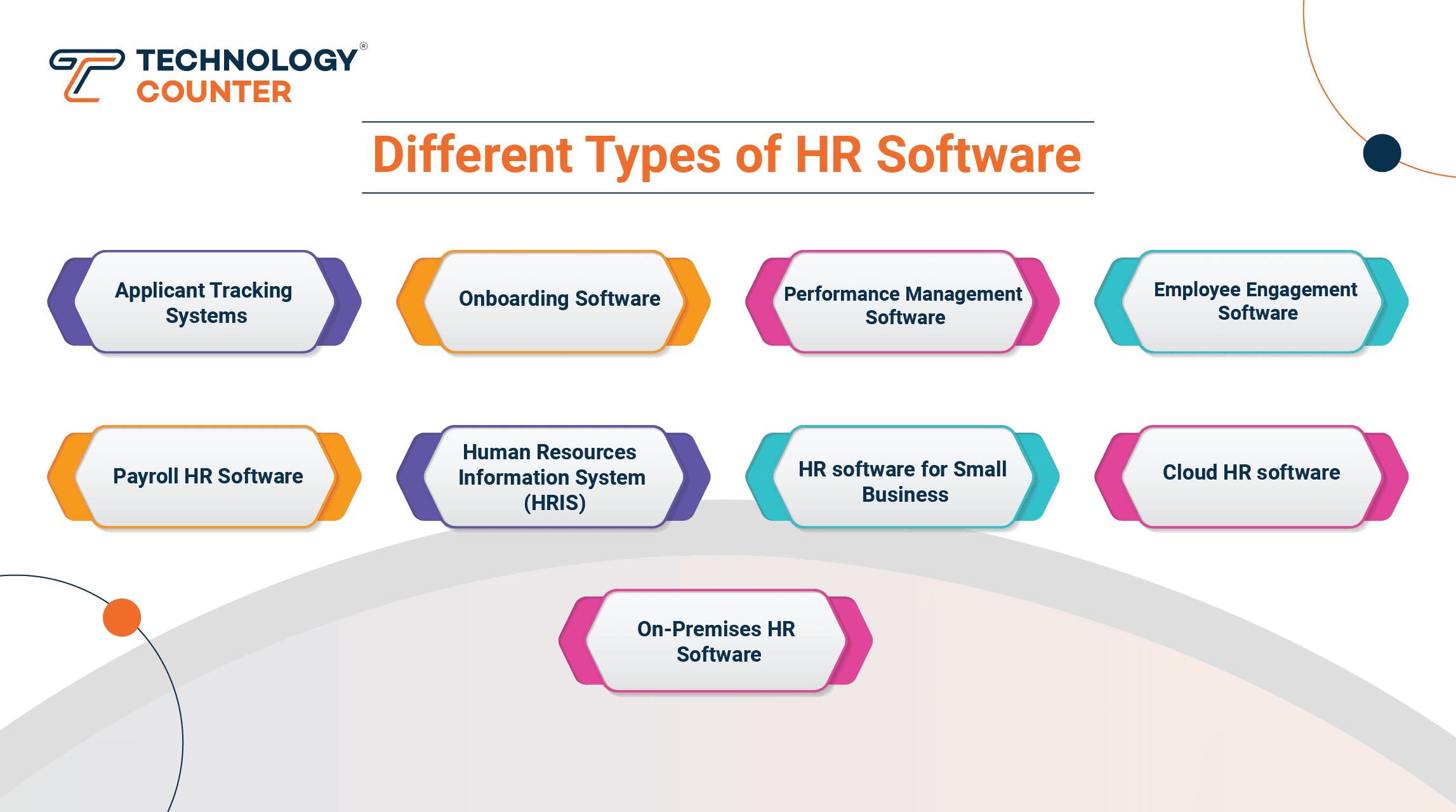
There are different types of employee software for every business need, size, and budget.
Some are specialized tools that focus on one area of HR while others are all-in-one systems that cover every part of managing employees.
Common types include:
Applicant Tracking Systems
Manage and automate the hiring process by communicating with candidates, handling resumes and applications, posting job ads, screening, scheduling interviews, and providing data analysis.
Onboarding Software
Create a smooth and engaging onboarding experience for new employees.
This includes ensuring compliance with labor laws, generating electronic forms, setting up equipment and software, offering a feedback channel for new hires and analyzing data.
Performance Management Software
It helps to manage how well your employees are performing. This includes giving feedback, setting goals, tracking progress, coaching, and supporting learning and development.
Employee Engagement Software
Measure and boost how engaged your employees are with your company. It can be done through surveys, rewards and recognition, and offering learning and development opportunities.
Payroll HR Software
Handle everything related to paying employees, such as following labor laws and tax rules, processing payroll, tracking work hours, managing benefits, and giving employees online access to their pay details.
Human Resources Information System (HRIS)
It provides a cost-effective means for companies to enhance their people management by integrating many HR tasks into a single system. It can include managing employee records, onboarding, payroll, performance tracking, recruiting, training, employee engagement, and ensuring compliance.
HR software for Small Business
Small enterprises are the target market for certain HR software.
Designed to address the particular requirements and difficulties faced by smaller firms, it provides the same capabilities as bigger systems. In this manner, you may avoid purchasing a more sophisticated system designed for large corporations.
Cloud HR software
Compared to on-premises systems, cloud based HR software offers several advantages. The software supplier keeps the data and applications on a distant server rather than on a server in your workplace.
This means:
-
It can easily grow with your company as you add more employees.
-
It's usually cheaper because it needs - less hardware, infrastructure, and IT support.
-
Security updates are handled automatically, keeping your data protected.
-
The software provider can automatically update and improve it.
-
You can access it from anywhere with an internet connection, making it great for remote and hybrid teams.
On-Premises HR Software
The company's own servers or PCs in the workplace are where on-premises HR software, also known as locally installed or self-hosted software, operates. Key details of on-premises HR software solutions are as follows:
-
It provides customizable choices to meet the unique requirements of the company.
-
The company's own systems hold the data. Therefore, they have complete control over data security.
-
Updating and maintaining the program is the responsibility of the company's IT staff.
-
Purchasing the required gear and software has up-front expenditures.
Pitfalls of Choosing Free HR Software Systems
The benefits of online HR software are clear. However, there are typical blunders you should steer clear of while purchasing and using a new instrument. The following are some errors to be aware of and how to prevent them:
-
Rushing the decision
It's easy to get excited about an attractive interface, good reviews, or product features. But that can lead to overlooking your team's specific needs. You may realize too late that the tool is missing a crucial feature. Always assess your team's needs, past issues, and company goals before making a decision. Make sure human resource management software is what you actually need.
-
Lack of awareness
Many HR managers choose software without fully understanding all the features it offers. They focus on solving one or two problems but miss out on other features that could improve several HR processes.
-
Not consulting teammates
Failing to ask for input from employees can lead to problems later. Managers and employees often need different features, and each group will prioritize different things. Checking with everyone in all departments can be time-consuming but it's worth it in the long run. Changing vendors after implementation can be expensive, even if the software is free.
-
Overlooking security and support
Budget constraints shouldn't cause you to ignore security and support. While some vendors offer excellent data handling and customer support, it's important to consider these aspects based on your team's specific needs.
Demo Questions for Vetting HR Software
The next step after reducing your HR management software alternatives is to try them out and determine which one best suits your company. Most tools on our list are simple to start using: just create an account, set a password, and you're good to go.
However, many also offer demo requests.
Whether you're trying a demo or using the software for the first time, it's important to approach it with a plan and some key questions. Start by considering your organization's needs, the tasks and HR processes you want to automate, and any integrations you might need.
After this, prepare a list of questions to guide your evaluation:
-
How can this tool improve the candidate experience?
-
How smoothly will this tool integrate with our existing tech setup?
-
How well does the vendor handle data security?
-
What can I learn about customer support quality? Does the platform have a useful help center with good support articles?
-
What challenges might make me or my team hesitant to switch to this platform?
-
Which features should I focus on testing?
-
Will other team members find this tool useful?
Implementing an HR Software
Once you choose the right human resource management system for your business, the implementation process will depend on the software you've selected. For open-source solutions, you'll likely need to communicate and collaborate closely with their team.
On the other hand, HR software allows you to get started in just a few minutes. Each vendor's page will give you more details on their specific process, and many will contact you via phone or email after you set up an account or request a demo to help with any questions or issues.
If you want to learn more about what to do after implementing HR software, including expert tips and proven methods, we've put together a helpful guide on HR software implementation.
Manage ALL your HR functions with ONE single platform! Start your free trial today!
HR Software Trends
Here are some key trends HR professionals and managers should watch for to stay ahead of industry demands:
Ongoing preference for remote work
In workplaces, working remotely will continue to be a popular option. In fact, 97% of employees want to work remotely for the rest of their lives, according to reports.
HR specialists must thus modify their scheduling strategies and depend on Internet platforms for essential functions. HR managers should also seek new technologies to support remote teamwork.
On the subject of the "Great Resignation"
The Great Resignation, or the mass resignations that followed the pandemic, is another factor pushing the development of HR software. Lack of professional development is one of the primary reasons for employee turnover.
Through gamification, webinars, and integrated training tools, advanced HR software may aid in skill improvement. Additionally, HR software can support mental health by providing access to mental wellness resources.
Millennials and Gen Z are taking over
Gen Z only makes up 5% of the workforce in the US, while millennials make up 35%. Younger people will make up most of the workforce, so social media, tablets, and the internet will become bigger parts of HR tools. To really connect with these tech-savvy groups, HR software needs to be mobile-friendly.
Impact of digital technology and automation
Automation is known for improving efficiency, especially in reducing manual tasks. HR software helps speed up approval times, manage data storage, and reduce paperwork. Furthermore, improvements in data security ensure that information gathered through software is protected from theft.
With this overview of market trends, statistics, and key shifts, here are 15 HR software examples and their top features to help HR professionals and administrators find the right platform for their needs.
What are the Average Implementation Times for HR Software?
The complexity of the software and the particular requirements of your company might have a significant impact on how long it takes to integrate HR software. It usually takes a few weeks to a number of months for simpler systems.
On the other hand, more complex systems may take several months to a year to fully implement especially if customization or integration with other systems is required. This phase typically involves setting up the system, migrating data, training users, and testing the system to make sure it runs smoothly.
Also read: Top HR software for startups.
How do HR Platforms Address Data Security?
Although every HR software system is unique protecting sensitive worker data both while it's being transferred. And when it's stored, it is essential for all systems. HR software developers ensure data security and compliance through these methods:
-
Compliance with international standards like GDPR and ISO/IEC 27001
-
Regular security audits
-
Single sign-on
-
Strong access controls to block unauthorized access
-
Two-factor authentication
It's important for businesses to check the security credentials and compliance certifications of each provider.
Conclusion
We hope that after reading this guide, choosing the right HR software is no longer as confusing as it was before. You should now have a better idea of what to expect from quality software that addresses your needs.
The key is knowing what to look for. Features such as a simplified HR routine, a centralized system, and tools that streamline HR tasks. To give your team more time for other activities are essential. If you don't see these in any HRMS software, you're likely not looking in the right place.
When making your choice, take a step-by-step approach. Align your organization's core needs with the features of the top options to get clarity.
It's also important to consider your budget and test the software through a demo. These steps will help you narrow down the choices to the best one for you. Trust your instincts choose software that feels right for your team and will deliver the efficiency, effectiveness, and productivity you need.
Good luck in selecting the right software for your HR team! Click here to explore
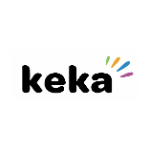
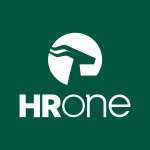
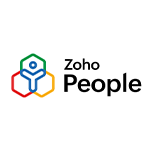
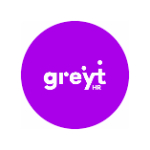
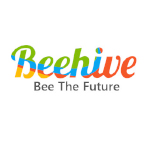

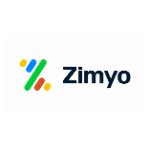
.png)
